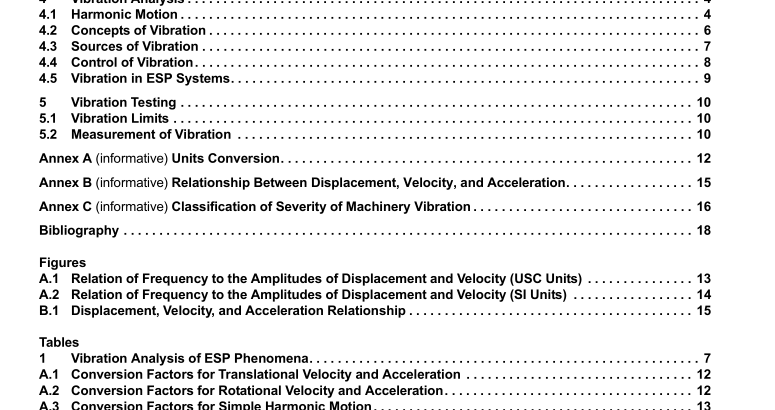API RP 11S8:2012 pdf free download.Recommended Practice on Electric Submersible System Vibrations
Misaligned couplings of shaft bearings can result in transverse vibration (vibration perpendicular to the shaft). Flexible couplings with angular misalignment may produce an axial mode of vibration. This is especially prominent in slender, long shafts. Misalignment may result in large axial vibration. A characteristic of misalignment and bent shafts is that vibration will occur in both radial and axial directions. In general, whenever the amplitude of axial vibration is greater than 50 % of the highest radial vibration, then misalignment or a bent shaft should be suspected.
4.3.4 Flow Induced Pump vibration can occasionally be caused by flow through the system. The amplitude usually depends upon where the pump is operated on the head-capacity curve. This normally causes a vibration due to turbulence. In diffuser-type pumps, certain combination of impeller blades and diffuser vanes are more likely to produce vibration than others. Although this phenomenon can produce vibration amplitudes that are unacceptable, especially at rates conducive to cavitation problems, testing indicates that when the pump is operated within its recommended operating range, the impact of turbulence is minimal. Nonsymmetrical fluid passages in a pump can induce hydraulic imbalance that may be seen as a once per revolution vibration. Multiphase flow can also induce vibration.
4.3.5 Journal Bearing Oil Whirl A condition caused by hydrodynamic forces in lightly loaded journal bearings that results in a vibration at slightly less than one-half (42 % to 48 %) the rotating frequency.
4.3.6 Bearing Rotation Journal bearings that are not properly secured can rotate with the shaft and produce vibration at one-half rotating frequency.
4.3.7 Mechanical Rub Contact between the rotating and stationary surfaces results in a vibration at a frequency normally 1 / 3 to 1 / 2 the operating speed. Natural frequencies may be excited.
4.4 Control of Vibration
4.4.1 General Methods of vibration control may be grouped into three broad categories: reduction at the source, isolation of external sources, and reduction of the response.
4.4.2 Reduction at the Source Methods of vibration control in this category include the following.
a) Balancing of rotating masses—Where vibration results from the unbalance of rotating components, the magnitude of the vibratory forces, and hence the vibration amplitude, can often be reduced by balancing.
b) Balancing of magnetic forces—Vibratory forces arising in magnetic effects of electrical machinery are minimized by proper design and fabrication of the stator and rotor, details of which are beyond the scope of this RP.
c) Control of clearances—Vibration can result when ESP system components and parts, operating within the clearances that exist between them, strike each other or otherwise come into impact-type contact during operation. Vibrations from this source can be minimized by avoiding excessive bearing clearances and by ensuring that dimensions of manufactured parts are within acceptable tolerances.
d) Straightness of rotating shaft—Rotating shafts should be as straight as practical since lack of shaft straightness will have a large effect on system vibrations.
4.4.3 Isolation of External Sources Other machines or equipment, unless properly isolated, may transmit vibration to an ESP under test or in operation. For example, a horizontal pump delivering high-pressure water may experience vibration interference from neighboring pumps and drivers through the foundation. Accepted practice is to avoid the structure’s natural frequency by approximately 25 % above or below. Isolation of equipment being tested is the responsibility of the tester. Isolation of equipment in service is the responsibility of the user.
4.4.4 Reduction of the Response Methods of vibration control in this category include the following.
a) Alteration of natural frequency—If a natural frequency of the system coincides with the frequency of the excitation, the vibration condition may be made much worse as a result of resonance. Under such circumstances, if the frequency of the excitation is substantially constant, it often is possible to alleviate the vibration by changing the natural frequency of such system. This generally involves modifying mass and/or stiffness of the system.
b) Operating at nonresonant frequencies—Sometimes ESPs are operated with variable speed drives. Operation at a frequency corresponding to a critical speed should be avoided to minimize damage to the system.
c) Additional damping—The vibration response of a system operating at resonance is strongly related to the amount of damping present. Techniques are available to increase the amount of damping. The addition of damping decreases unit efficiency.API RP 11S8 pdf download.API RP 11S8:2012 pdf free download
